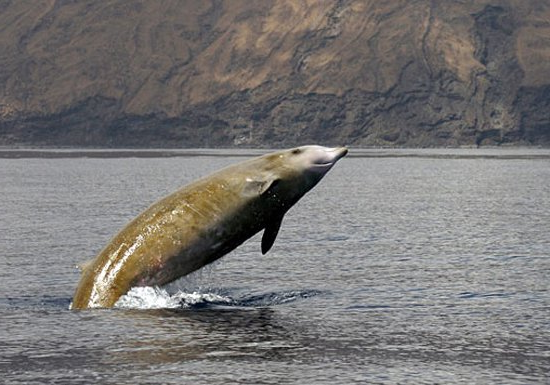Classification:
Kingdom: Animalia
Phylum: Chordata
Class: Mammalia
Order: Artiodactyla
Infraorder: Cetacea
Family: Ziphiidae
Genus: Ziphius
Species:
Z. cavirostris
Get the facts:
Cuvier’s beaked whales, also known as “goose-beaked whales” are found in most oceans and seas worldwide. Their deep diving habits makes it very difficult to study them so there are still many secrets to unveil from this species. They have the record of being the marine mammal with the longest and deepest dive. Sadly, they are also the most frequently stranded whale species.
Species identification:
Cuvier’s beaked whales have a robust and torpedo-shaped body. Their average size, for both males and females, is around 6.1 m but there are individuals that exceed 7.0m. They weigh around 3000 kg. Cuvier’s beaked whales have a small falcate dorsal fin that is located approximately two-thirds of the way back on the body. Their flippers are also small and narrow, and they can tuck their flippers into a pocket or depression in order to make their bodies streamlined. Their flukes are relatively large and lack the medial notch found in other cetaceans. Their head is rather cone-shaped, with a short beak and two throat grooves. This species feed mainly by suction and the grooves allows them to expand their throat in order to suck their prey. In terms of colouration, Cuvier’s beaked whales are dark grey over most of their body except their belly and head which are lighter. Males, especially older individuals, are characterised for their white colouration in their head and also on much of their back. The colouration of females do not vary so much as it happens with males. Newborns are usually black or bluish black except for their underside which is lighter. They have black oval patches around each eye. Also, their body might have oval scars due to bites from predators, or scratches from teeth marks caused by other males during a fight.
Diet:
The diet of Cuvier’s beaked whales mainly consists of squid, but occasionally, they eat fish and crustaceans. This species dive, both during the day and night, looking for squid.
Habitat:
Cuvier’s beaked whales are found in all temperate, subtropical and tropical waters. They commonly live in deep offshore waters, with deeps over 1000 meters, and around banks, seamounts and submarine canyons. Still is not well known the migration patterns or seasonality of this species.
Behaviour:
Cuvier’s beaked whales are hard to find as they only spend short periods in the surface to breathe and sleep. Most of the time they are found in deeper waters. They are timid animals so they rarely breach and avoid vessels. This species evolved to forage in depths of more than 1000 meters and can dive for 30 minutes at a time. The deepest recorded dive was 2992 meters and the longest dive around 90 minutes. Cuvier’s beaked whales only make noise in the deepest part of their dive, and ascend horizontally at a low angle and not vertically like other species. Researchers believe that they do this in order to hide from killer whales; one of their main predators. They silently ascend back to to surface and the horizontal low-angled ascend allows them to travel further from the starting point of the dive where killer whales might be expecting them.
Social Structure:
Cuvier’s beaked whales seem to be less social; they are often found alone or in small groups of 2 or 7 individuals. The high number of loners indicate that there is no selective pressure for grouping. The groups formed are for predation avoidance and for mating opportunities. For example, females with small calves are most likely to associate with other individuals, mainly other adult females, in order to reduce the risk of predation. Their groups tend to have more than one male which shows that polygyny is not as strong as other beaked whale species. Their social relations seem to be transitory but there is a documented long-term relation between a pair of individuals. The scars on males clearly show that there is competition between them for mating with females, but it also seems that sperm competition is important. A pair of males appeared to be cooperating to sequester a female from other males in order to mate with her; by cooperating, this increases the chance that the offspring will be from either one of them.
Reproduction:
The average size of a female when it reaches sexual maturity is about 5.80 m, and for males is 5.5 m. In terms of age, it is estimated that they reach sexual maturity when they become 11 years old. The mean length at birth is 2.7m.
Vocalisations:
Cuvier’s beaked whales produce sounds such as clicks and buzzes for echolocation when they forage. Beaked whales’ whistles or other tonal vocalisations have been rarely recorded.
Lifespan:
The maximum estimated lifespan is 60 years old.
Global Distribution:
Cuvier’s beaked whales are widely distributed in the world except for the Arctic and the high latitudes of the Antarctic.
Population Status:
There are no global population estimates but it is considered one of the most abundant beaked whale species, with probably a population over 100.000 whales. They are listed in the IUCN list as a “Least Concern (LC)” species.
Threats to Survival:
Cuvier’s beaked whales are known to be very sensitive to navy sonars. They can become frightened from a man-made noise, which causes them to travel too quickly to the surface. As a result, they can suffer from decompression sickness which can lead to their death. It is believed that mass strandings are related with the decompression sickness events. Other threats for this species are entanglement in fishing gear, hunting and vessel strikes. Most likely, they are vulnerable to pollution and climate change but this has to be further studied.






